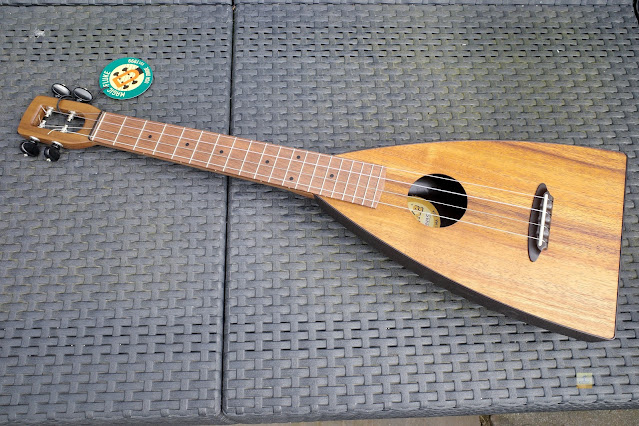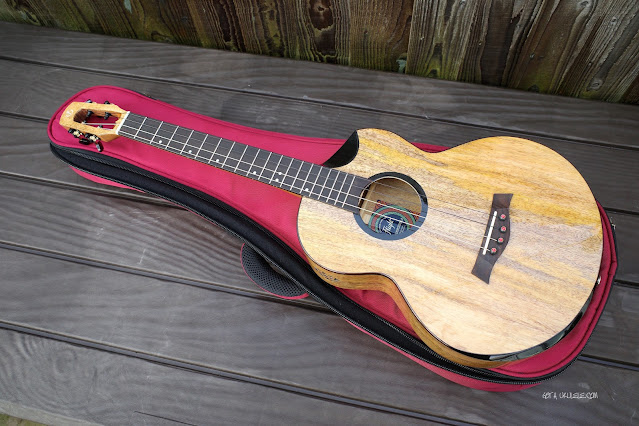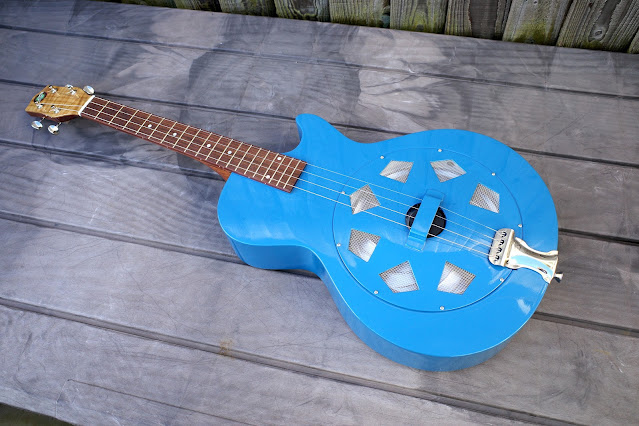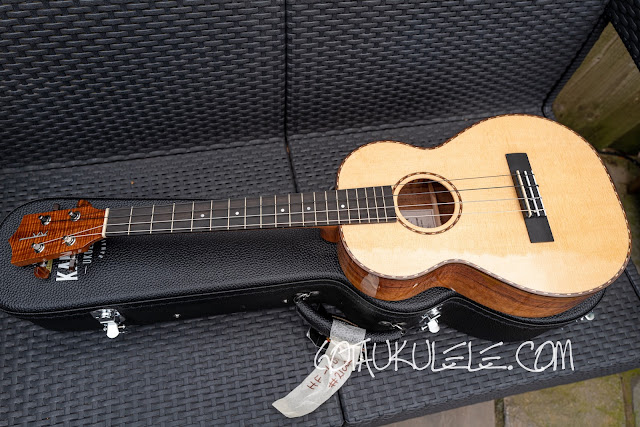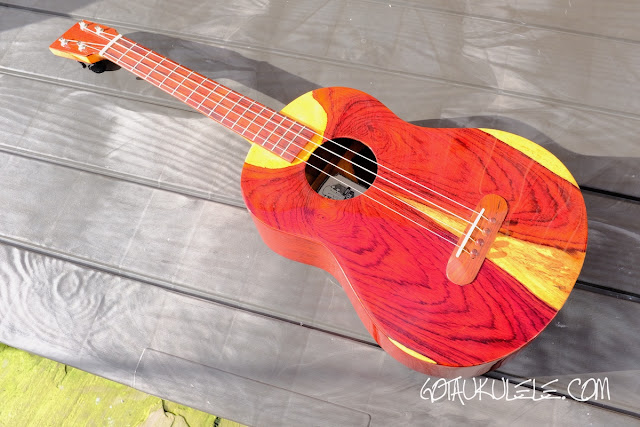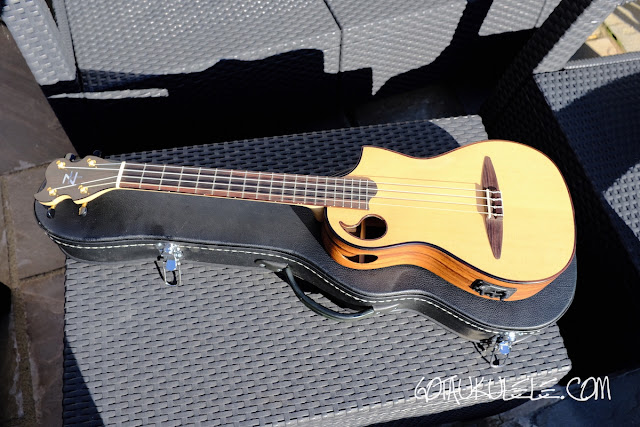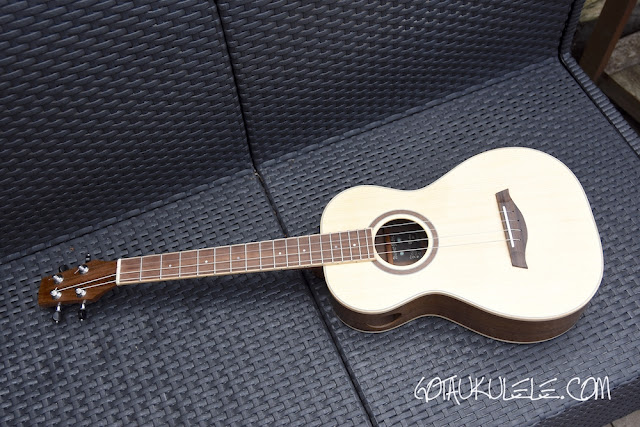- UKULELE REVIEWS
- UKULELE CHORD CHART and FRETBOARD PAGE
- UKULELE BEGINNERS TIPS
- UKULELE SONG TAB and CHORDS
- UKULELE CLUBS AND SOCIETIES
- UKULELE TUITION
- UKULELE BEGINNERS VIDEOS
- UKULELE FESTIVAL CALENDAR
- UKULELE STORES
- UKULELE GLOSSARY
- UKULELE RANTS
- GOT A UKULELE MERCH
- UKULELE LUTHIERS and HAND MADE BUILDERS
- UKULELE ACTS FOR HIRE
- INTERVIEWS
- PRIVACY
- CONTACT ME / ABOUT ME / PRESS
SEARCH GOT A UKULELE
Want To Say Thank You?
Showing posts with label baritone. Show all posts
Showing posts with label baritone. Show all posts
12 May 2024
5 May 2024
11 Feb 2024
11 Feb 2024T13:58
Read More »
Kala KA-CT-SA-BG Contour Baritone Ukulele - REVIEW
It's not often I look at two ukuleles from the same series, but with my desire to give more exposure to baritone ukes on this site, when the invitation to borrow this one from Kala came along, I couldn't say no. This is the Kala KA-CT-SA-BG Baritone from their new 'Contour Series'.
3 Dec 2023
3 Dec 2023T14:28
Read More »
Flight Aurora EQ-A Baritone Ukulele - REVIEW
Back once again with a ukulele brand that regularly appears on this site - this is the Flight Aurora EQ-A Baritone Ukulele.
5 Nov 2023
5 Nov 2023T14:42
Read More »
Snail SUB-M1 Baritone Ukulele - REVIEW
Time for a ukulele scale that I don't feature enough on Got A Ukulele (not for lack of trying). This is the Snail SUB-M1 Baritone - an instrument where all is not quite as it seems.
23 Jul 2023
23 Jul 2023T14:47
Read More »
Kanile'a K-1 B Baritone Deluxe Ukulele - REVIEW
Following on with a series of dream ukuleles, I'm delighted to be able to get my hands on this Kanile'a K-1 B Deluxe Baritone.
26 Mar 2023
26 Mar 2023T14:50
Read More »
Sound Smith SSG-03 Guitalele - REVIEW
I've been longing to get another instrument from this ukulele brand on the site for some time. This is the new Sound Smith SSG-03 Guitalele.
10 Dec 2022
10 Dec 2022T14:27
Read More »
Flight Fireball EQ-A Baritone Ukulele - REVIEW
Got A Ukulele seems to have done a lot better lately with the 'big guns' - and so it is that I was rather excited to take a look at this. This is the Flight Fireball EQ-A Baritone.
27 Nov 2022
27 Nov 2022T14:49
Read More »
Beltona Super Baritone Ukulele - REVIEW
Something very special and very different in the ukulele world this week. I'm delighted to have Beltona back on the site with the Beltona Super Baritone Ukulele.
30 Oct 2021
30 Oct 2021T16:40
Read More »
Noah Super Tenor Ukulele - REVIEW
A return with for a brand much featured on Got A Ukulele and a brand new model for them. This is the Noah Super Tenor.
15 Aug 2021
15 Aug 2021T15:01
Read More »
Kamaka HF-4DS Deluxe Spruce and Koa Baritone Ukulele - REVIEW
One of those ukulele reviews this week that show me how lucky I am to get to do this. It will also please the Baritone fiends out there. This is the Kamaka HF-4DS Deluxe Baritone.
1 Mar 2020
1 Mar 2020T13:17
Read More »
Bonanza Homestead Baritone Ukulele REVIEW
Over the last few years I have learned that it's always a fun weekend when a Bonanza Ukulele comes my way for review. This week I am looking at the Bonanza Homestead Baritone.
23 Feb 2020
23 Feb 2020T13:13
Read More »
NFC Ukuleles Baritone - REVIEW
It's fair to say that Got A Ukulele has featured instruments from all corners of the globe. But perhaps one of the more unusual locations is Nicaragua. And I suppose it's then even more unusual to find myself reviewing a second yet different brand from that country. This is a Baritone ukulele built by NFC Ukuleles.
25 Nov 2019
25 Nov 2019T12:28
Read More »
Isuzi EAK-B Baritone Ukulele - REVIEW
I know all too well that I don't feature enough baritone ukuleles on Got A Ukulele. It's not through want of trying, I can assure you as I love them. They just don't seem to come up too much in the requests I get from brands. I'm glad to help redress the balance a bit today with the Isuzi EAK-B Baritone ukulele.
23 Jun 2019
23 Jun 2019T11:04
Read More »
ZT Baritone Ukulele - REVIEW
Not that long ago I was introduced to the ukulele design skills of Zachary Taylor when I had a chance to try his Tenor model. And what a terrific instrument that was! Since then I have been keen to look at Zachary's own personal favourite scale - the Baritone. Luckily I managed to get one of those on loan.
23 Dec 2018
23 Dec 2018T11:43
Read More »
Duke DUBVB Baritone Ukulele - REVIEW
Regular readers of Got A Ukulele will know I am passionate about steering shoppers towards true specialist ukulele dealers. And it's always nice when one of those dealers chooses to put out their own model of ukulele. Say hello to the Duke DUBVB Vintage Burst Baritone.
Labels:
baritone
,
duke of uke
,
laminate
,
mahogany
,
reviews
23 Jun 2018
23 Jun 2018T12:44
Read More »
Paul Barnard Wildcat Baritone Ukulele - REVIEW
Mixing things up again this week on the Got A Ukulele reviews page, as it's another hand made ukulele review. Added to that it's a type of ukulele I have been meaning to feature more of as it's a baritone. This one is hand made by Paul Barnard at Wildcat Ukuleles and Guitars.
19 Mar 2017
19 Mar 2017T10:22
Read More »
Kala KA-ABP-CTG Baritone Ukulele - REVIEW
It's nice to have Kala brand back on the Got A Ukulele reviews bench, and this time we wheel out the big guns in the form of a baritone scale ukulele. The Kala KA-ABP-CTG.
4 Feb 2017
4 Feb 2017T12:38
Read More »
Ohana BK-70 Baritone Ukulele - REVIEW
Always good to redress the balance a little in favour of baritone ukuleles on the Got A Ukulele reviews page. So it's nice to be looking at a brand for which i've never seen one of their baritones up close before. The Ohana BK-70.
29 Sept 2016
29 Sept 2016T17:55
Firstly, some years ago the more common tuning for the soprano ukulele was actually D tuning (which is ADF#B) and of course the most common tuning for the Baritone tends to be in G tuning (or DGBE). In fact, many banjolele players today will still use that D tuning as they prefer the sound and string tension. It gets more complicated when you realise that years ago the original tuning for tenor ukuleles was actually G tuning yet today most people go with C tuning and many Baritone players today go for C tuning..... So no, GCEA is only the standard of common convention TODAY.
And what is common between all these other tunings is that they have the individual strings in the same interval relationship to each other. That is to say, they are effectively the same tunings but just in different keys either a bit up or a bit down in pitch.
What does that mean? Well for a new player, the most important thing to bear in mind is that because that relationship between the strings is the same in C, D or G tuning (or any other that has the same relationship), the chord SHAPES themselves will still work no matter what tuning you use. Of course, the shape you play will then play a different chord to the chord you get in C tuning, but they still work as chord shapes. Understanding what those chord shapes then become is key to unlocking the ease of working with ANY other relative tuning.
What I hear most commonly from people who are reluctant to try alternative keys is that they 'don't want to learn a whole new bunch of chords' or 'i'm still struggling with this tuning'. In fact, it's that reason that so many people are now choosing to tune their baritones to C tuning or even playing sopraninos at the ear piercing, shrill a whole octave above C tuning. They are doing it because they think it gets complicated when you change and they prefer to play what they know. And this post is intended to show you that it really isn't complicated at all. In fact it's easy. You already know it.
First of all, you really just need to understand the musical scale on a keyboard..
Or even better, print off a copy of the Circle Of Fifths that shows the notes of the scale in an order separated by musical fifths.
A musical fifth can be heard by using a piano keyboard and counting up 7 half steps including the black keys. That is to say a total of 7 physical piano keys upwards. (And why 5ths, and not 7ths? Well because the 5ths refers the 5 intervals, which in a perfect 5th is made up of 7 semitones!) So from a C on the keyboard graphic shown above, the fifth above it is the note of G, being 7 keys (or 7 half steps / semitones) up from the C. Count them on the keyboard above to see. The next note in the circle of fifths, (and indeed all the notes work the same way) - 7 up from the G on the piano is D, 7 from the D is the note of A, and so on. Now do the same on the Circle of Fifths - you will see that because of how it is laid out, that 7 piano key step up from C to get G is immediately next to the C on the Circle. Likewise, the 7 piano key step from G to D - on the Circle, the D is next to the G. That's because the Circle is counting the fifths, or the 7 half steps! (Incidentally - the Circle Of Fifths is helpful in all sorts of other ways in music - such as transposing and finding chord relationships etc)). Oh, and for this purpose - don't worry about the inner circle - that's not used for this level of transposing.
Anyway, I said this was easy, so let's put the theory away and get back to re-tuned ukuleles. As I say, a common factor that puts people off is the thought that they will have to learn a bunch of new chords. Bear in mind though, if you know your chord shapes for GCEA tuning, you already know the chord shapes for other key tunings so long as you keep the relationship between the strings the same!
So lets look at the most common example - the move from C tuning to G tuning that players will face if they buy a baritone. We already know the chords in standard C tuning (called C tuning after that third string) and we know the baritone is in G tuning (the tuning of the third string again). Looking at the Circle of Fifths, we see that the G is therefore a fifth up from the note of C, as indicated by the fact it is immediately to the right of the C on the Circle. (And yes, I know that Baritones are tuned lower than C tuned ukuleles, but it is still in the key of G and the Circle of Fifths doesn't alter between octaves). So we know that the G tuned ukulele is a fifth up from the C tuned ukulele or one space up on the Circle. It therefore also follows that every C tuning shaped chord played on the G tuned ukulele will be a fifth up, or rather, one space clockwise on the Circle. And knowing that, and having the Circle with you will unlock the simple way of transposing.
Play a C chord shape on the baritone - you get a G chord - one step round on the circle. Play a G chord shape on the baritone and you get a D (one space up on the Circle), play an A chord shape on the baritone and, you guessed it you get an E. And it applies to every chord shape you know on the C tuned ukulele - if you play that chord on a G tuned baritone, it will play the chord name of the next note on the Circle. Basically every chord will be the same step up as the G is from the C. (Incidentally, don't get foxed by minor or 7th chords - just use the Circle to tell you the root key - so C7 shape on the Baritone, plays a G7 etc.)
And this works with any tuning so long as the string relationship is the same. I mentioned above the common practice of tuning sopranino ukuleles with C tuning but a whole octave above the soprano. I think it sounds shrill and overly bright myself and I therefore prefer to tune mine in F tuning (CFAD). I just think it's nicer on the ears. And once again people look in horror and say, 'but I don't know the chord shapes for that!'. You DO know them, for exactly the same reason as above.
Back to the Circle of Fifths - we note that the F is one step to the left of the C. Therefore, if you play a C chord shape on an F tuned ukulele you get an F chord. Play a G chord shape on an F tuned ukulele and again, using the circle to go one step to the left, you get a C chord. Play an A chord shape and you get a D. All of them being one step to the left on the circle. It works for all chords.
Want to go really exotic? - what about tuning to A tuning (EAC#F#) - I've never done that, but bear with me! Again, using the circle and we note that the A is three steps round to the right from the C. So playing a C chord shape will give you an A, playing a G chord shape gives you an E. And so on.
And that really is all there is to it. Yes, you could use a piano keyboard to work out the fifths sequence if you like, but just printing off the Circle (or memorising it) is so much easier. Use the circle to work out the relationship between the chord shapes you already know in C tuning and the key you want to tune to - and that difference in numbers of steps left or right from C on the Circle can be applied to all the chord shapes.
I hope that helps and I really hope it means that people will stop being worried about moving to Baritone. Heck, I LOVE Baritone ukes and they are no harder to play than any other! Bear in mind that this article just deals with changing the key tuning of the ukulele whilst keeping the string intervals the same, and doesn't apply to other more exotic tunings like dropped strings and open chords, but I may save that for another post! Have fun!
© Barry Maz
Read More »
Don't Be Afraid of Alternative Ukulele Key Tunings
Something I realised I hadn't written about in my ukulele beginners tips section
And that of using alternative tunings on the ukulele. Then I seemed to get a flurry of questions on email from readers who were experimenting with new tunings on their musical instruments. Thought it was therefore about time to look at this in a little more detail. First up, one of the most common myths you will see written about the ukulele is that standard tuning is GCEA (or rather gCEA with a small g to signify that re-entrant G, or GCEA if you are using low G). And that's it.... People think that IS the way to tune a ukulele, or more particularly, the ONLY way to tune them.... But that actually misses some pretty important aspects aside from it just not being true.Firstly, some years ago the more common tuning for the soprano ukulele was actually D tuning (which is ADF#B) and of course the most common tuning for the Baritone tends to be in G tuning (or DGBE). In fact, many banjolele players today will still use that D tuning as they prefer the sound and string tension. It gets more complicated when you realise that years ago the original tuning for tenor ukuleles was actually G tuning yet today most people go with C tuning and many Baritone players today go for C tuning..... So no, GCEA is only the standard of common convention TODAY.
And what is common between all these other tunings is that they have the individual strings in the same interval relationship to each other. That is to say, they are effectively the same tunings but just in different keys either a bit up or a bit down in pitch.
What does that mean? Well for a new player, the most important thing to bear in mind is that because that relationship between the strings is the same in C, D or G tuning (or any other that has the same relationship), the chord SHAPES themselves will still work no matter what tuning you use. Of course, the shape you play will then play a different chord to the chord you get in C tuning, but they still work as chord shapes. Understanding what those chord shapes then become is key to unlocking the ease of working with ANY other relative tuning.
What I hear most commonly from people who are reluctant to try alternative keys is that they 'don't want to learn a whole new bunch of chords' or 'i'm still struggling with this tuning'. In fact, it's that reason that so many people are now choosing to tune their baritones to C tuning or even playing sopraninos at the ear piercing, shrill a whole octave above C tuning. They are doing it because they think it gets complicated when you change and they prefer to play what they know. And this post is intended to show you that it really isn't complicated at all. In fact it's easy. You already know it.
First of all, you really just need to understand the musical scale on a keyboard..
Or even better, print off a copy of the Circle Of Fifths that shows the notes of the scale in an order separated by musical fifths.
A musical fifth can be heard by using a piano keyboard and counting up 7 half steps including the black keys. That is to say a total of 7 physical piano keys upwards. (And why 5ths, and not 7ths? Well because the 5ths refers the 5 intervals, which in a perfect 5th is made up of 7 semitones!) So from a C on the keyboard graphic shown above, the fifth above it is the note of G, being 7 keys (or 7 half steps / semitones) up from the C. Count them on the keyboard above to see. The next note in the circle of fifths, (and indeed all the notes work the same way) - 7 up from the G on the piano is D, 7 from the D is the note of A, and so on. Now do the same on the Circle of Fifths - you will see that because of how it is laid out, that 7 piano key step up from C to get G is immediately next to the C on the Circle. Likewise, the 7 piano key step from G to D - on the Circle, the D is next to the G. That's because the Circle is counting the fifths, or the 7 half steps! (Incidentally - the Circle Of Fifths is helpful in all sorts of other ways in music - such as transposing and finding chord relationships etc)). Oh, and for this purpose - don't worry about the inner circle - that's not used for this level of transposing.
Anyway, I said this was easy, so let's put the theory away and get back to re-tuned ukuleles. As I say, a common factor that puts people off is the thought that they will have to learn a bunch of new chords. Bear in mind though, if you know your chord shapes for GCEA tuning, you already know the chord shapes for other key tunings so long as you keep the relationship between the strings the same!
So lets look at the most common example - the move from C tuning to G tuning that players will face if they buy a baritone. We already know the chords in standard C tuning (called C tuning after that third string) and we know the baritone is in G tuning (the tuning of the third string again). Looking at the Circle of Fifths, we see that the G is therefore a fifth up from the note of C, as indicated by the fact it is immediately to the right of the C on the Circle. (And yes, I know that Baritones are tuned lower than C tuned ukuleles, but it is still in the key of G and the Circle of Fifths doesn't alter between octaves). So we know that the G tuned ukulele is a fifth up from the C tuned ukulele or one space up on the Circle. It therefore also follows that every C tuning shaped chord played on the G tuned ukulele will be a fifth up, or rather, one space clockwise on the Circle. And knowing that, and having the Circle with you will unlock the simple way of transposing.
Play a C chord shape on the baritone - you get a G chord - one step round on the circle. Play a G chord shape on the baritone and you get a D (one space up on the Circle), play an A chord shape on the baritone and, you guessed it you get an E. And it applies to every chord shape you know on the C tuned ukulele - if you play that chord on a G tuned baritone, it will play the chord name of the next note on the Circle. Basically every chord will be the same step up as the G is from the C. (Incidentally, don't get foxed by minor or 7th chords - just use the Circle to tell you the root key - so C7 shape on the Baritone, plays a G7 etc.)
And this works with any tuning so long as the string relationship is the same. I mentioned above the common practice of tuning sopranino ukuleles with C tuning but a whole octave above the soprano. I think it sounds shrill and overly bright myself and I therefore prefer to tune mine in F tuning (CFAD). I just think it's nicer on the ears. And once again people look in horror and say, 'but I don't know the chord shapes for that!'. You DO know them, for exactly the same reason as above.
Back to the Circle of Fifths - we note that the F is one step to the left of the C. Therefore, if you play a C chord shape on an F tuned ukulele you get an F chord. Play a G chord shape on an F tuned ukulele and again, using the circle to go one step to the left, you get a C chord. Play an A chord shape and you get a D. All of them being one step to the left on the circle. It works for all chords.
Want to go really exotic? - what about tuning to A tuning (EAC#F#) - I've never done that, but bear with me! Again, using the circle and we note that the A is three steps round to the right from the C. So playing a C chord shape will give you an A, playing a G chord shape gives you an E. And so on.
And that really is all there is to it. Yes, you could use a piano keyboard to work out the fifths sequence if you like, but just printing off the Circle (or memorising it) is so much easier. Use the circle to work out the relationship between the chord shapes you already know in C tuning and the key you want to tune to - and that difference in numbers of steps left or right from C on the Circle can be applied to all the chord shapes.
I hope that helps and I really hope it means that people will stop being worried about moving to Baritone. Heck, I LOVE Baritone ukes and they are no harder to play than any other! Bear in mind that this article just deals with changing the key tuning of the ukulele whilst keeping the string intervals the same, and doesn't apply to other more exotic tunings like dropped strings and open chords, but I may save that for another post! Have fun!
© Barry Maz
Labels:
articles
,
baritone
,
beginner tips
,
beginners
,
chords
,
circle of fifths
,
keys
,
sopranino
,
tuning
Subscribe to:
Posts
(
Atom
)
Help Support Got A Ukulele
Please Help Keep This Site Going!
If you enjoy this blog, donations are welcomed to allow me to invest more time in bringing you ukulele articles. Aside from the Google ads, I don't get paid to write this blog and for reasons of impartiality a not sponsored by brands or stores. Your donations all go back into the site to allow me to keep bringing you reviews, and in the end the ukuleles acquired are given to local schools and charities.

